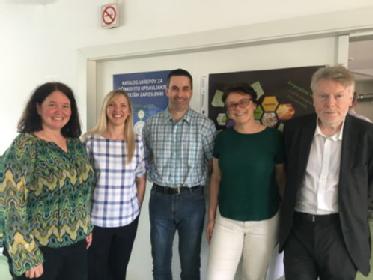IER News & blogs
Quality (and lack) of employment linked to mental health-related disability
 A new article was published in the International Archives of Occupational and Environmental Health by Rebeka Balogh, Sudipa Sarkar, Chris Warhurst and colleagues at Interface Demography at the Vrije Universiteit Brussel and the Karolinska Institute.
A new article was published in the International Archives of Occupational and Environmental Health by Rebeka Balogh, Sudipa Sarkar, Chris Warhurst and colleagues at Interface Demography at the Vrije Universiteit Brussel and the Karolinska Institute.
The article examines the link between types of employment trajectories and Belgium workers having a subsequent registered disability from mental health.
IER research rated highly at IAEVG conference
 A range of IER research was presented at the recent 44th International Association for Educational and Vocational Guidance (IAEVG) online international conference 'Maximizing Potential of Career Guidance'. The conference was attended by career guidance and counselling professionals to share research and practice on how career guidance can maximise the potential of individuals and communities, education and economies.
A range of IER research was presented at the recent 44th International Association for Educational and Vocational Guidance (IAEVG) online international conference 'Maximizing Potential of Career Guidance'. The conference was attended by career guidance and counselling professionals to share research and practice on how career guidance can maximise the potential of individuals and communities, education and economies.
Profiling of job seekers to help target support - Blog by Dr Sally Wright
 While we may be in unprecedented times, a picture is already starting to emerge about the colossal impact that Covid-19 is having on labour markets, jobs and people.
While we may be in unprecedented times, a picture is already starting to emerge about the colossal impact that Covid-19 is having on labour markets, jobs and people.
The measures being implemented by countries to address the spread of Covid-19 are necessary as they will save lives but they are having a devastating impact on workers around the world. For example, in mid-March 2020, the International Labour Organisation (ILO) estimated that lockdown measures had already affected around 2.7 billion workers, representing around 81% of the world’s workforce. Moreover, the pandemic has intensified and expanded since the ILO’s initial estimates were published.
Distance travelled and soft outcomes for long-term unemployed review

The feasibility of developing a methodology for measuring the distance travelled and soft outcomes for long-term unemployed people participating in Active Labour Market Programmes has just been published by the European Commission.
Sally-Anne Barnes and Sally Wright undertook the review as part of the ESF funded European Transnational Employment Platform Project led by AEIDL. The aim of the review was to establish the scope for application of 'Distance Travelled Models', which could be adapted by those supporting long-term employed integration.
Sally-Anne and Sally also delivered a half day workshop for the Slovenian public employment services to support the development of a distance travelled model for the labour market programmes.
IER team visited India for project launch workshop in spring 2019


In late April/early May Clare Lyonette, Gaby Atfield and Sudipa Sarkar visited India for the first of a series of workshops as part of the ESRC Global Challenges Research Fund project 'Inequalities and skills acquisition in young people: Identification of factors affecting successful outcomes in the DDU-GKY Indian skills programme for unemployed young people’.
The IER team was joined by Bhaskar Chakravorty, an IER PhD student and research assistant, and Himadri Sinha, co-investigator on the project, based at Xavier Institute of Social Service (XISS). During the first workshop visit, the IER team delivered workshops to Master's students at XISS on quantitative and qualitative research methods, as well as engaged with key local stakeholders.
